warning VOLVO V60 2018 Owner´s Manual
[x] Cancel search | Manufacturer: VOLVO, Model Year: 2018, Model line: V60, Model: VOLVO V60 2018Pages: 406, PDF Size: 9.59 MB
Page 4 of 406
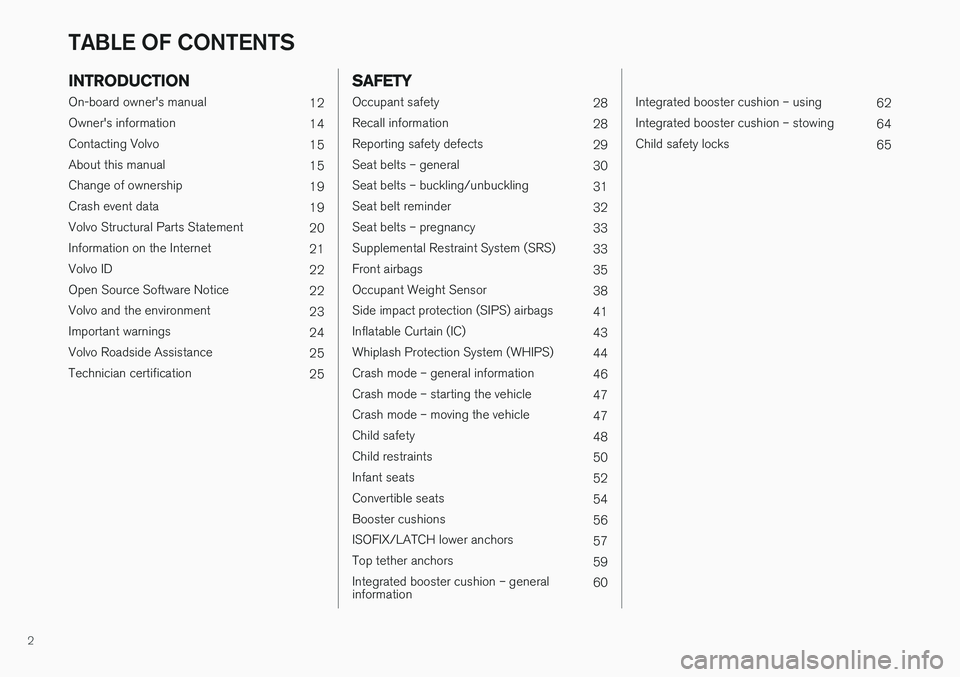
2
INTRODUCTION
On-board owner's manual12
Owner's information 14
Contacting Volvo 15
About this manual 15
Change of ownership 19
Crash event data 19
Volvo Structural Parts Statement 20
Information on the Internet 21
Volvo ID 22
Open Source Software Notice 22
Volvo and the environment 23
Important warnings 24
Volvo Roadside Assistance 25
Technician certification 25
SAFETY
Occupant safety28
Recall information 28
Reporting safety defects 29
Seat belts – general 30
Seat belts – buckling/unbuckling 31
Seat belt reminder 32
Seat belts – pregnancy 33
Supplemental Restraint System (SRS) 33
Front airbags 35
Occupant Weight Sensor 38
Side impact protection (SIPS) airbags 41
Inflatable Curtain (IC) 43
Whiplash Protection System (WHIPS) 44
Crash mode – general information 46
Crash mode – starting the vehicle 47
Crash mode – moving the vehicle 47
Child safety 48
Child restraints 50
Infant seats 52
Convertible seats 54
Booster cushions 56
ISOFIX/LATCH lower anchors 57
Top tether anchors 59
Integrated booster cushion – general information 60
Integrated booster cushion – using
62
Integrated booster cushion – stowing 64
Child safety locks 65
TABLE OF CONTENTS
Page 5 of 406
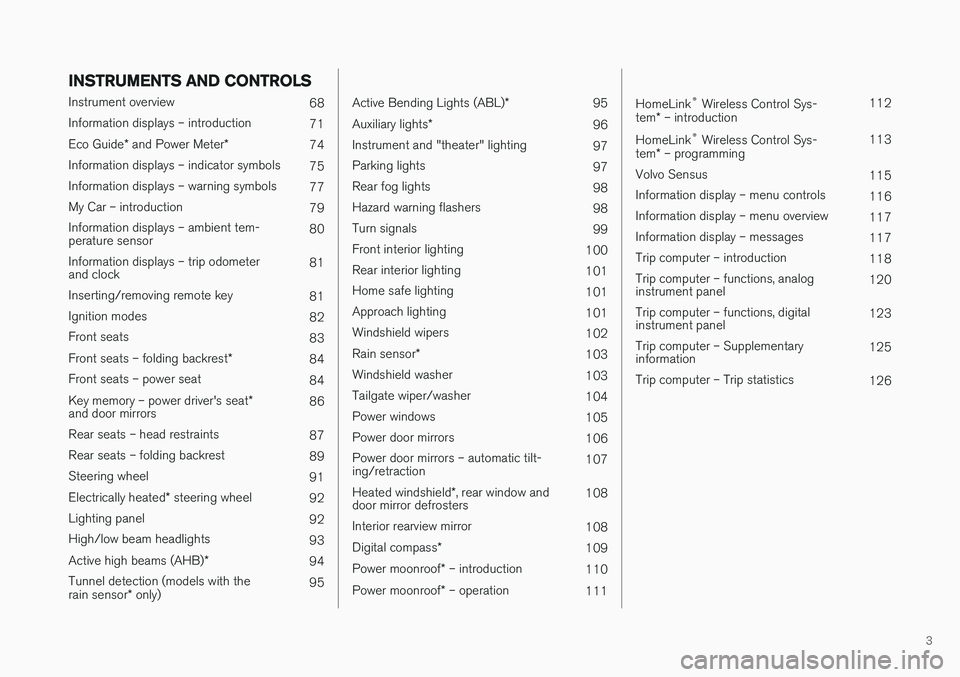
3
INSTRUMENTS AND CONTROLS
Instrument overview 68
Information displays – introduction 71
Eco Guide * and Power Meter *
74
Information displays – indicator symbols 75
Information displays – warning symbols 77
My Car – introduction 79
Information displays – ambient tem- perature sensor 80
Information displays – trip odometerand clock 81
Inserting/removing remote key 81
Ignition modes 82
Front seats 83
Front seats – folding backrest *
84
Front seats – power seat 84
Key memory – power driver's seat *
and door mirrors 86
Rear seats – head restraints 87
Rear seats – folding backrest 89
Steering wheel 91
Electrically heated * steering wheel
92
Lighting panel 92
High/low beam headlights 93
Active high beams (AHB) *
94
Tunnel detection (models with the rain sensor * only) 95
Active Bending Lights (ABL)
*
95
Auxiliary lights *
96
Instrument and "theater" lighting 97
Parking lights 97
Rear fog lights 98
Hazard warning flashers 98
Turn signals 99
Front interior lighting 100
Rear interior lighting 101
Home safe lighting 101
Approach lighting 101
Windshield wipers 102
Rain sensor *
103
Windshield washer 103
Tailgate wiper/washer 104
Power windows 105
Power door mirrors 106
Power door mirrors – automatic tilt- ing/retraction 107
Heated windshield *, rear window and
door mirror defrosters 108
Interior rearview mirror 108
Digital compass *
109
Power moonroof * – introduction
110
Power moonroof * – operation
111
HomeLink®
Wireless Control Sys-
tem * – introduction 112
HomeLink ®
Wireless Control Sys-
tem * – programming 113
Volvo Sensus 115
Information display – menu controls 116
Information display – menu overview 117
Information display – messages 117
Trip computer – introduction 118
Trip computer – functions, analog instrument panel 120
Trip computer – functions, digitalinstrument panel 123
Trip computer – Supplementaryinformation 125
Trip computer – Trip statistics 126
Page 7 of 406
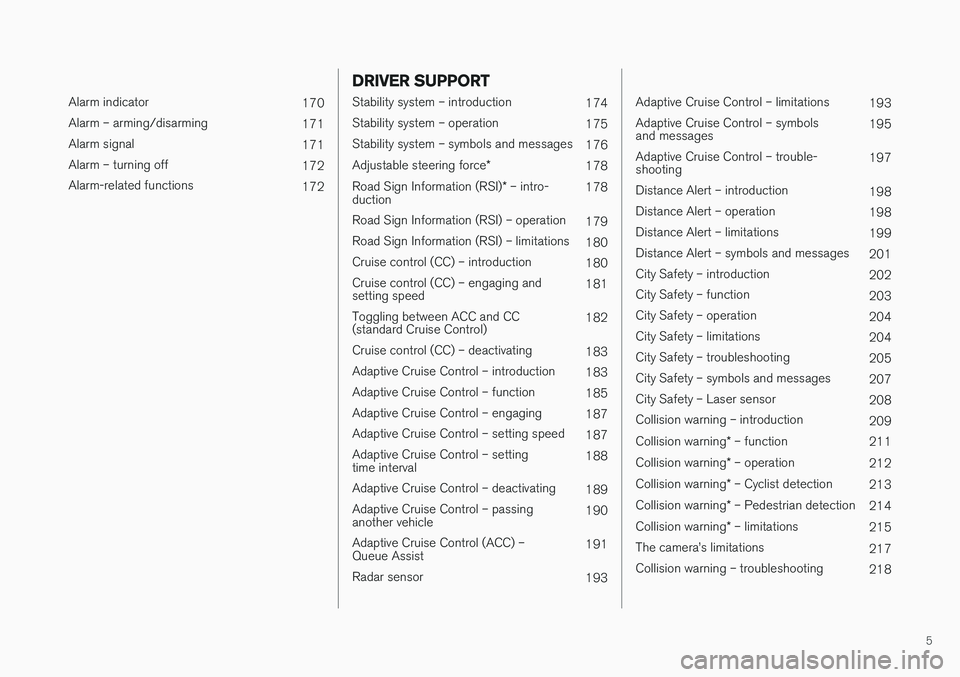
5
Alarm indicator170
Alarm – arming/disarming 171
Alarm signal 171
Alarm – turning off 172
Alarm-related functions 172
DRIVER SUPPORT
Stability system – introduction174
Stability system – operation 175
Stability system – symbols and messages 176
Adjustable steering force *
178
Road Sign Information (RSI) * – intro-
duction 178
Road Sign Information (RSI) – operation 179
Road Sign Information (RSI) – limitations 180
Cruise control (CC) – introduction 180
Cruise control (CC) – engaging and setting speed 181
Toggling between ACC and CC(standard Cruise Control) 182
Cruise control (CC) – deactivating 183
Adaptive Cruise Control – introduction 183
Adaptive Cruise Control – function 185
Adaptive Cruise Control – engaging 187
Adaptive Cruise Control – setting speed 187
Adaptive Cruise Control – settingtime interval 188
Adaptive Cruise Control – deactivating 189
Adaptive Cruise Control – passinganother vehicle 190
Adaptive Cruise Control (ACC) –Queue Assist 191
Radar sensor 193
Adaptive Cruise Control – limitations193
Adaptive Cruise Control – symbols and messages 195
Adaptive Cruise Control – trouble-shooting 197
Distance Alert – introduction 198
Distance Alert – operation 198
Distance Alert – limitations 199
Distance Alert – symbols and messages 201
City Safety – introduction 202
City Safety – function 203
City Safety – operation 204
City Safety – limitations 204
City Safety – troubleshooting 205
City Safety – symbols and messages 207
City Safety – Laser sensor 208
Collision warning – introduction 209
Collision warning * – function
211
Collision warning * – operation
212
Collision warning * – Cyclist detection
213
Collision warning * – Pedestrian detection
214
Collision warning * – limitations
215
The camera
Page 8 of 406
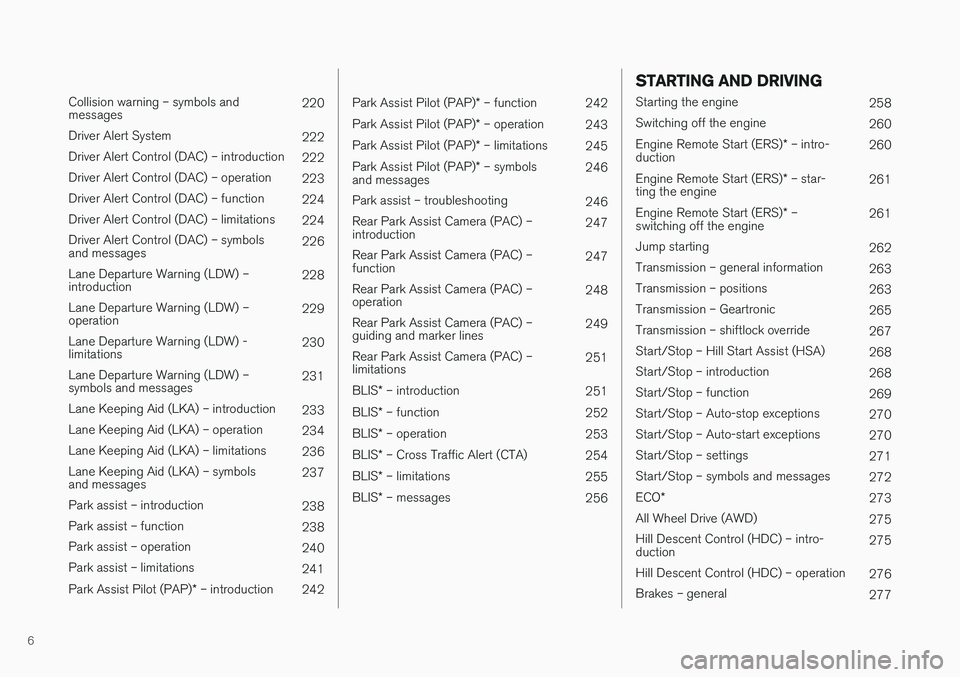
6
Collision warning – symbols and messages220
Driver Alert System 222
Driver Alert Control (DAC) – introduction 222
Driver Alert Control (DAC) – operation 223
Driver Alert Control (DAC) – function 224
Driver Alert Control (DAC) – limitations 224
Driver Alert Control (DAC) – symbolsand messages 226
Lane Departure Warning (LDW) –introduction 228
Lane Departure Warning (LDW) –operation 229
Lane Departure Warning (LDW) -limitations 230
Lane Departure Warning (LDW) –symbols and messages 231
Lane Keeping Aid (LKA) – introduction 233
Lane Keeping Aid (LKA) – operation 234
Lane Keeping Aid (LKA) – limitations 236
Lane Keeping Aid (LKA) – symbolsand messages 237
Park assist – introduction 238
Park assist – function 238
Park assist – operation 240
Park assist – limitations 241
Park Assist Pilot (PAP) * – introduction
242
Park Assist Pilot (PAP) * – function
242
Park Assist Pilot (PAP) * – operation
243
Park Assist Pilot (PAP) * – limitations
245
Park Assist Pilot (PAP) * – symbols
and messages 246
Park assist – troubleshooting 246
Rear Park Assist Camera (PAC) – introduction 247
Rear Park Assist Camera (PAC) –function 247
Rear Park Assist Camera (PAC) –operation 248
Rear Park Assist Camera (PAC) –guiding and marker lines 249
Rear Park Assist Camera (PAC) –limitations 251
BLIS * – introduction
251
BLIS * – function
252
BLIS * – operation
253
BLIS * – Cross Traffic Alert (CTA)
254
BLIS * – limitations
255
BLIS * – messages
256
STARTING AND DRIVING
Starting the engine
258
Switching off the engine 260
Engine Remote Start (ERS) * – intro-
duction 260
Engine Remote Start (ERS) * – star-
ting the engine 261
Engine Remote Start (ERS) * –
switching off the engine 261
Jump starting 262
Transmission – general information 263
Transmission – positions 263
Transmission – Geartronic 265
Transmission – shiftlock override 267
Start/Stop – Hill Start Assist (HSA) 268
Start/Stop – introduction 268
Start/Stop – function 269
Start/Stop – Auto-stop exceptions 270
Start/Stop – Auto-start exceptions 270
Start/Stop – settings 271
Start/Stop – symbols and messages 272
ECO *
273
All Wheel Drive (AWD) 275
Hill Descent Control (HDC) – intro- duction 275
Hill Descent Control (HDC) – operation 276
Brakes – general 277
Page 10 of 406
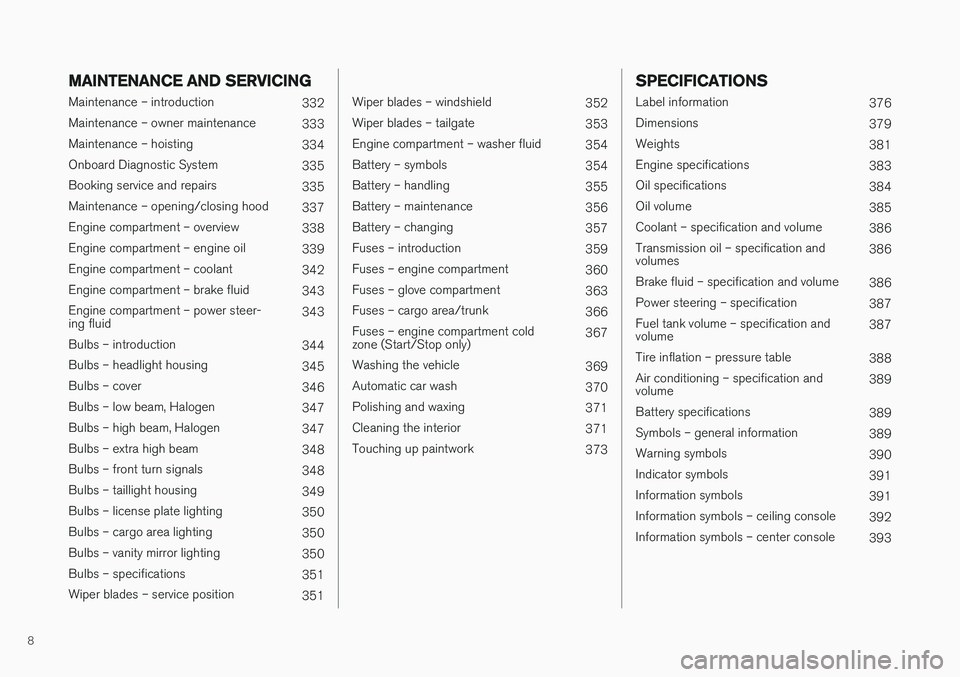
8
MAINTENANCE AND SERVICING
Maintenance – introduction332
Maintenance – owner maintenance 333
Maintenance – hoisting 334
Onboard Diagnostic System 335
Booking service and repairs 335
Maintenance – opening/closing hood 337
Engine compartment – overview 338
Engine compartment – engine oil 339
Engine compartment – coolant 342
Engine compartment – brake fluid 343
Engine compartment – power steer- ing fluid 343
Bulbs – introduction 344
Bulbs – headlight housing 345
Bulbs – cover 346
Bulbs – low beam, Halogen 347
Bulbs – high beam, Halogen 347
Bulbs – extra high beam 348
Bulbs – front turn signals 348
Bulbs – taillight housing 349
Bulbs – license plate lighting 350
Bulbs – cargo area lighting 350
Bulbs – vanity mirror lighting 350
Bulbs – specifications 351
Wiper blades – service position 351
Wiper blades – windshield352
Wiper blades – tailgate 353
Engine compartment – washer fluid 354
Battery – symbols 354
Battery – handling 355
Battery – maintenance 356
Battery – changing 357
Fuses – introduction 359
Fuses – engine compartment 360
Fuses – glove compartment 363
Fuses – cargo area/trunk 366
Fuses – engine compartment cold zone (Start/Stop only) 367
Washing the vehicle 369
Automatic car wash 370
Polishing and waxing 371
Cleaning the interior 371
Touching up paintwork 373
SPECIFICATIONS
Label information376
Dimensions 379
Weights 381
Engine specifications 383
Oil specifications 384
Oil volume 385
Coolant – specification and volume 386
Transmission oil – specification and volumes 386
Brake fluid – specification and volume 386
Power steering – specification 387
Fuel tank volume – specification andvolume 387
Tire inflation – pressure table 388
Air conditioning – specification andvolume 389
Battery specifications 389
Symbols – general information 389
Warning symbols 390
Indicator symbols 391
Information symbols 391
Information symbols – ceiling console 392
Information symbols – center console 393
Page 15 of 406
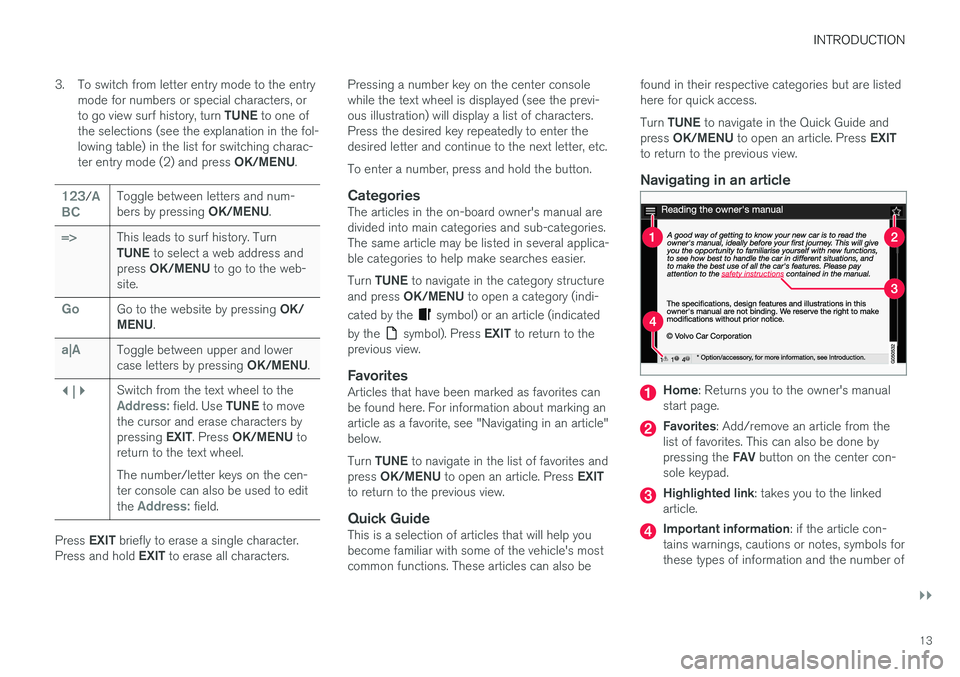
INTRODUCTION
}}
13
3. To switch from letter entry mode to the entry
mode for numbers or special characters, or to go view surf history, turn TUNE to one of
the selections (see the explanation in the fol- lowing table) in the list for switching charac- ter entry mode (2) and press OK/MENU.
123/A
BCToggle between letters and num- bers by pressing OK/MENU.
=>This leads to surf history. Turn TUNE to select a web address and
press OK/MENU to go to the web-
site.
GoGo to the website by pressing OK/
MENU .
a|AToggle between upper and lower case letters by pressing OK/MENU.
| | }Switch from the text wheel to theAddress: field. Use TUNE to move
the cursor and erase characters by pressing EXIT. Press OK/MENU to
return to the text wheel. The number/letter keys on the cen- ter console can also be used to edit the
Address: field.
Press EXIT briefly to erase a single character.
Press and hold EXIT to erase all characters. Pressing a number key on the center console while the text wheel is displayed (see the previ-ous illustration) will display a list of characters.Press the desired key repeatedly to enter thedesired letter and continue to the next letter, etc. To enter a number, press and hold the button.
CategoriesThe articles in the on-board owner's manual are divided into main categories and sub-categories.The same article may be listed in several applica-ble categories to help make searches easier. Turn
TUNE to navigate in the category structure
and press OK/MENU to open a category (indi-
cated by the
symbol) or an article (indicated
by the
symbol). Press EXIT to return to the
previous view.
FavoritesArticles that have been marked as favorites can be found here. For information about marking anarticle as a favorite, see "Navigating in an article"below. Turn TUNE to navigate in the list of favorites and
press OK/MENU to open an article. Press EXIT
to return to the previous view.
Quick GuideThis is a selection of articles that will help you become familiar with some of the vehicle's mostcommon functions. These articles can also be found in their respective categories but are listedhere for quick access. Turn
TUNE to navigate in the Quick Guide and
press OK/MENU to open an article. Press EXIT
to return to the previous view.
Navigating in an article
Home : Returns you to the owner's manual
start page.
Favorites : Add/remove an article from the
list of favorites. This can also be done by pressing the FAV button on the center con-
sole keypad.
Highlighted link : takes you to the linked
article.
Important information : if the article con-
tains warnings, cautions or notes, symbols for these types of information and the number of
Page 17 of 406

INTRODUCTION
}}
15
WARNING
The driver is always responsible for operating the vehicle in a safe manner and for comply-ing with current statutes and regulations. It is also essential to maintain and service the vehicle according to Volvo's recommendationsas stated in the owner's information and theservice and warranty booklet. If the on-board information differs from the printed owner's manual, the printed informa-tion always takes precedence.
Contacting Volvo
In the USA:Volvo Car USA, LLC
Customer Care Center 1 Volvo Drive,P.O. Box 914 Rockleigh, New Jersey 076471-800-458-1552www.volvocars.com/us In Canada: Volvo Car Canada Ltd. Customer Care Centre9130 Leslie Street, Suite 101Richmond Hill, Ontario L4B 0B91-800-663-8255www.volvocars.com/ca
Related information
• About this manual (p. 15)
• Important warnings (p. 24)
• Crash event data (p. 19)
• Volvo Structural Parts Statement (p. 20)
About this manual
Reading your owner's manual is a good way to familiarize yourself with the features and systemsin your vehicle.
• Before you operate your vehicle for the first time, we recommend that you look throughthe information found in the chapters "YourDriving Environment" and "During Your Trip."
• Information contained in the balance of themanual is extremely useful and should beread after operating the vehicle for the firsttime.
• The manual is structured so that it can beused for reference. For this reason, it shouldbe kept in the vehicle for ready access.
On-board owner's manualWhen the printed manual refers to the on-boardowner's manual, this pertains to the informationdisplayed on the center console screen. The language used on the center console screen and instrument panel can be changed in the
MY
CAR system settings menu.
NOTE
Please be aware that changing languages to one that you do not understand may make itdifficult to change back to the original lan-guage.
Page 19 of 406
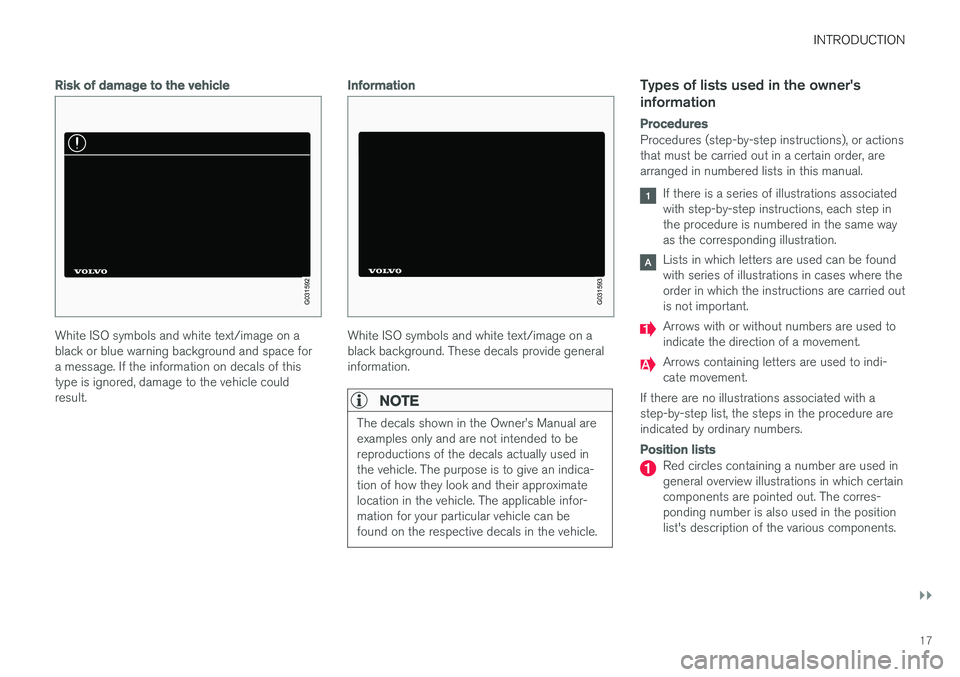
INTRODUCTION
}}
17
Risk of damage to the vehicle
G031592
White ISO symbols and white text/image on a black or blue warning background and space fora message. If the information on decals of thistype is ignored, damage to the vehicle couldresult.
Information
G031593
White ISO symbols and white text/image on a black background. These decals provide generalinformation.
NOTE
The decals shown in the Owner
Page 20 of 406
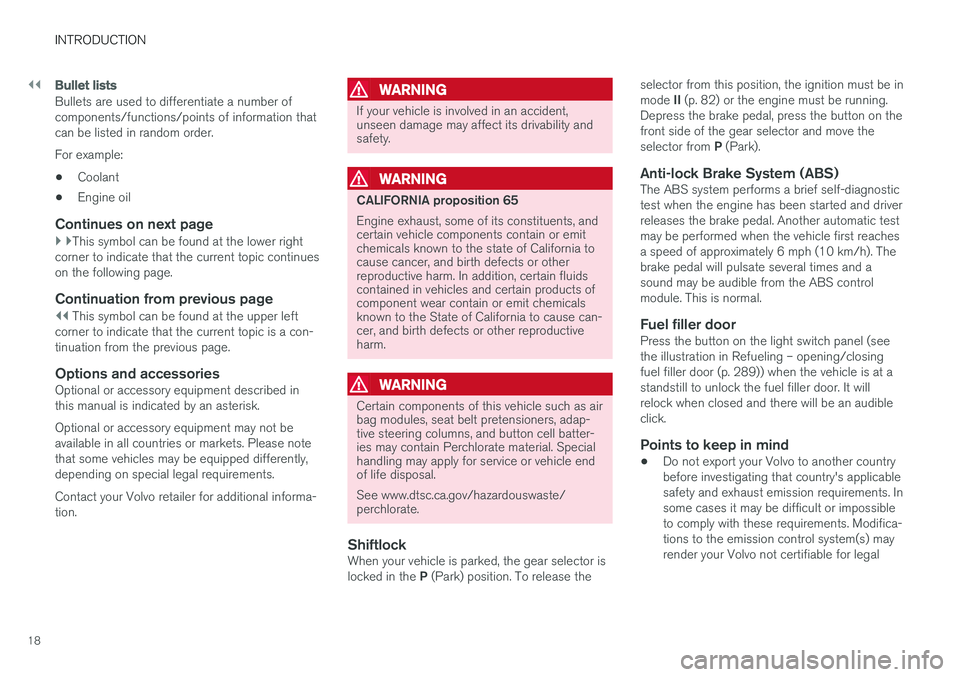
||
INTRODUCTION
18
Bullet lists
Bullets are used to differentiate a number of components/functions/points of information thatcan be listed in random order. For example:• Coolant
• Engine oil
Continues on next page
}
}This symbol can be found at the lower right
corner to indicate that the current topic continues on the following page.
Continuation from previous page
|| This symbol can be found at the upper left
corner to indicate that the current topic is a con- tinuation from the previous page.
Options and accessoriesOptional or accessory equipment described inthis manual is indicated by an asterisk. Optional or accessory equipment may not be available in all countries or markets. Please notethat some vehicles may be equipped differently,depending on special legal requirements. Contact your Volvo retailer for additional informa- tion.
WARNING
If your vehicle is involved in an accident, unseen damage may affect its drivability andsafety.
WARNING
CALIFORNIA proposition 65 Engine exhaust, some of its constituents, and certain vehicle components contain or emitchemicals known to the state of California tocause cancer, and birth defects or otherreproductive harm. In addition, certain fluidscontained in vehicles and certain products ofcomponent wear contain or emit chemicalsknown to the State of California to cause can-cer, and birth defects or other reproductiveharm.
WARNING
Certain components of this vehicle such as air bag modules, seat belt pretensioners, adap-tive steering columns, and button cell batter-ies may contain Perchlorate material. Specialhandling may apply for service or vehicle endof life disposal. See www.dtsc.ca.gov/hazardouswaste/ perchlorate.
ShiftlockWhen your vehicle is parked, the gear selector is locked in the P (Park) position. To release the selector from this position, the ignition must be inmode
II (p. 82) or the engine must be running.
Depress the brake pedal, press the button on the front side of the gear selector and move the selector from P (Park).
Anti-lock Brake System (ABS)The ABS system performs a brief self-diagnostic test when the engine has been started and driverreleases the brake pedal. Another automatic testmay be performed when the vehicle first reachesa speed of approximately 6 mph (10 km/h). Thebrake pedal will pulsate several times and asound may be audible from the ABS controlmodule. This is normal.
Fuel filler doorPress the button on the light switch panel (seethe illustration in Refueling – opening/closingfuel filler door (p. 289)) when the vehicle is at astandstill to unlock the fuel filler door. It willrelock when closed and there will be an audibleclick.
Points to keep in mind
• Do not export your Volvo to another countrybefore investigating that country's applicablesafety and exhaust emission requirements. Insome cases it may be difficult or impossibleto comply with these requirements. Modifica-tions to the emission control system(s) mayrender your Volvo not certifiable for legal
Page 21 of 406
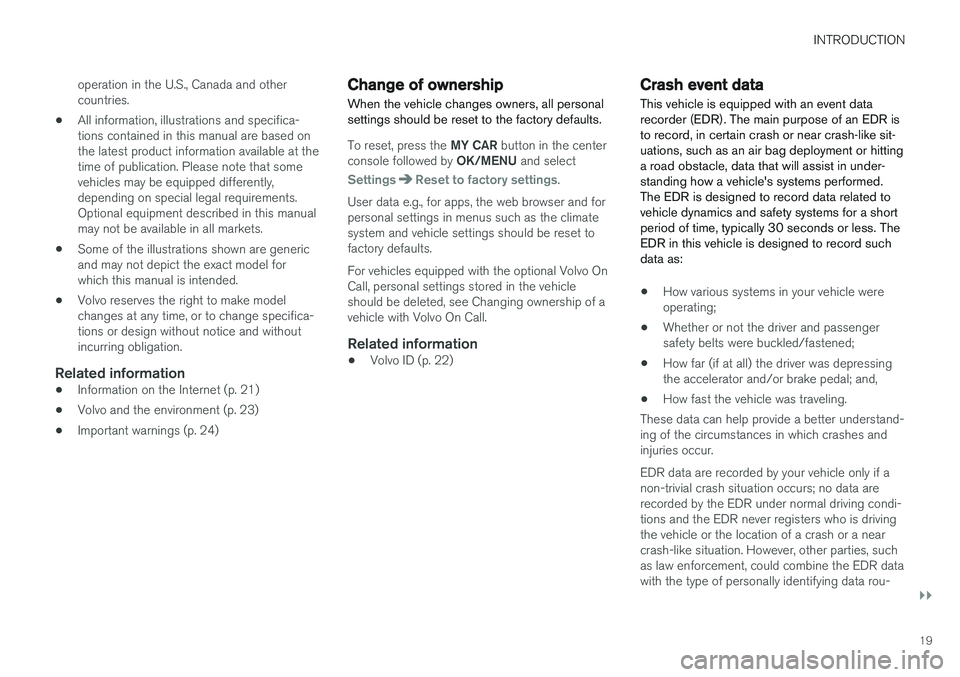
INTRODUCTION
}}
19
operation in the U.S., Canada and other countries.
• All information, illustrations and specifica-tions contained in this manual are based onthe latest product information available at thetime of publication. Please note that somevehicles may be equipped differently,depending on special legal requirements.Optional equipment described in this manualmay not be available in all markets.
• Some of the illustrations shown are genericand may not depict the exact model forwhich this manual is intended.
• Volvo reserves the right to make modelchanges at any time, or to change specifica-tions or design without notice and withoutincurring obligation.
Related information
•
Information on the Internet (p. 21)
• Volvo and the environment (p. 23)
• Important warnings (p. 24)
Change of ownership
When the vehicle changes owners, all personal settings should be reset to the factory defaults.
To reset, press the MY CAR button in the center
console followed by OK/MENU and select
SettingsReset to factory settings.
User data e.g., for apps, the web browser and for personal settings in menus such as the climatesystem and vehicle settings should be reset tofactory defaults. For vehicles equipped with the optional Volvo On Call, personal settings stored in the vehicleshould be deleted, see Changing ownership of avehicle with Volvo On Call.
Related information
• Volvo ID (p. 22)
Crash event data
This vehicle is equipped with an event data recorder (EDR). The main purpose of an EDR isto record, in certain crash or near crash-like sit-uations, such as an air bag deployment or hittinga road obstacle, data that will assist in under-standing how a vehicle's systems performed.The EDR is designed to record data related tovehicle dynamics and safety systems for a shortperiod of time, typically 30 seconds or less. TheEDR in this vehicle is designed to record suchdata as:
• How various systems in your vehicle were operating;
• Whether or not the driver and passengersafety belts were buckled/fastened;
• How far (if at all) the driver was depressingthe accelerator and/or brake pedal; and,
• How fast the vehicle was traveling.
These data can help provide a better understand-ing of the circumstances in which crashes andinjuries occur. EDR data are recorded by your vehicle only if a non-trivial crash situation occurs; no data arerecorded by the EDR under normal driving condi-tions and the EDR never registers who is drivingthe vehicle or the location of a crash or a nearcrash-like situation. However, other parties, suchas law enforcement, could combine the EDR datawith the type of personally identifying data rou-